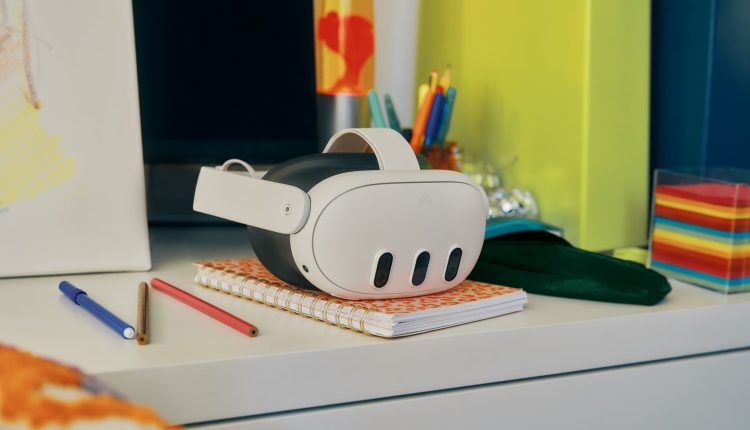Meta announced Quest 3, a sequel to the bestselling VR headset of all time, on Wednesday.
The device, starting at $499, is more expensive than its predecessor by $200, but it includes a more powerful chip from Qualcomm, better screens and an ability called “passthrough” which is expected to be one of the key features on Apple’s competing Vision Pro headset.
Preorders open on Wednesday and it ships on Oct. 10.
The defining feature of the Quest 3 headset is the ability to quickly see the world outside the headset, which will make the device less isolating and thus more comfortable to use for long periods. When in an app on the Quest 3, double-tapping any part of the headset brings you out of a virtual world and into “passthrough” mode.
Other improvements include “pancake lenses,” a kind of optic first used on Meta’s $1,499 Quest Pro that make images sharper and allows for higher resolution.
The release of Meta’s latest VR headset comes as a battle looms with Apple in virtual reality. Many in the technology industry believe Apple’s entrance could expand the total market and create new winners, similar to how the iPhone jump-started the smartphone market.
So far Meta, the company formerly known as Facebook, has a head start. Its Quest 2 is by far the bestselling VR headset, with nearly 10 million units sold last year, slightly down from a pandemic peak, according to an industry estimate. Apple’s Vision Pro headset won’t go on sale until next year, and costs significantly more than Meta’s headsets, starting at $3,499.
But despite Meta’s current success in sales, it’s not clear just how many Quest 2 owners use it on a daily or weekly basis, and the killer app or must-have scenario for VR remains elusive. Meta has invested over $21 billion to date in its Reality Labs division, which develops headsets and VR software.
Passthrough
CNBC was able to try out the Quest 3 for about an hourlong demo ahead of its launch Wednesday that included game playing and being walked through a few programs that showed off the company’s hardware.
The hardware has been significantly updated, with a new headband strap and a slimmer headset shape. The headband splits the top strap into two to better distribute weight. The whole headset, though, is a hair heavier than its predecessor at 515 grams. The speakers on the device also have been improved, and provide a quality audio experience.
Meta has also updated the two necessary controllers with better haptic feedback. It uses Qualcomm‘s Snapdragon XR2 Gen 2 chip, which is Arm-based and closer in power and energy drain to a mobile processor than a PC processor.
The extra power on the chip is used to power displays at 2,064 x 2,208 resolution per eye, higher than the Quest 2’s 1,832 x 1,920 resolution per eye. The additional pixels will make it easier to read text inside the headset. Users can expect about two hours and 12 minutes of battery life, Meta says.
During the demo, I tried out Samba de Amigo, a $30 game from Sega that is like Dance Dance Revolution or Rock Band with maracas (in real life, the Quest 3 controllers). I enjoyed it, and even sweated a little bit.
The biggest improvement to usability is that the Quest 3 emphasizes passthrough, which means the cameras outside the device can show live video on the displays inside the headset, working somewhat like a transparent pair of glasses that can also show computer windows and other graphics. The Quest 3 can also scan the room around you so apps can warn you when you’re about to bump into your surroundings.
Passthrough, while a core component of mixed-reality experiences which integrate computer graphics with the real world, for now is a nice-to-have usability feature. In practice, it means that users can stop their game or experience inside the Quest 3 without taking the headset off. During the demo, I was able to chat with Meta officials while wearing the headset, a major improvement over the last version.
Meta’s launch of the Quest 3 will be compared to Apple’s more expensive Vision Pro headset. But while Apple packed as much pricey technology into its headset as possible to enable its own passthrough mode it calls “spatial computing,” Meta is seeking to match many of its features, or at least an approximation of them, at a fraction of the price. Meta’s $1,499 Quest Pro is a lower-volume product.
But if there’s one major difference between Meta and Apple at this point, it’s that the former envisions the Quest mainly as a gaming device, while Apple frames its device as a computer. Meta says it’s lined up 500 games and apps for the headset, including a Ghostbusters title, an Assassin’s Creed game, and a Stranger Things experience developed in conjunction with Netflix.
Read the full article here

